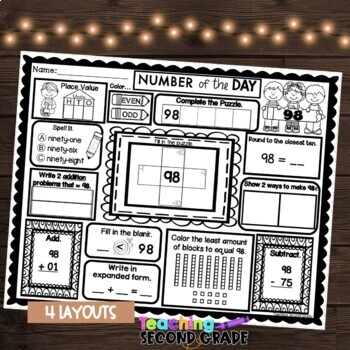Number of the Day Worksheets for 2nd Grade 1st Grade Math Daily Morning Work
- Zip
What educators are saying
Also included in
- Math Worksheets for 1st and 2nd GradeThese worksheets are great for review, math centers or stations, early or fast finishers, homework, morning work, seat work, and more.This bundle includes2 Digit Addition with and without RegroupingNumber of the DayAddition Facts and Strategies2nd Grade Math WorkPrice $14.70Original Price $24.70Save $10.00
Description
Help your 2nd-grade students improve their number sense skills with this Number of the Day 2nd Grade Math resource. Your students will dig into a variety of number sense activities all designed to help them work with and understand numbers fluently.
A strong number sense foundation helps students in all areas of math, including higher-level math. Help them build this foundation in just a few minutes each day with these No Prep Number of the Day worksheets designed for 2nd grade math skills.
No Prep 2nd Grade Number of the Day Worksheets includes:
- 80 Number of the Day worksheets
- 2 digit and 3 digit numbers included
- Numbers only go to 400 (not including every number)
- Blank pages to use with any number
These daily math worksheets are perfect to use as morning work, seat work, a math center, or homework.
No Prep 2nd Grade Number of the Day Worksheets cover:
- writing numbers
- tally marks
- identifying the value of a number
- addition (2 digit and 3 digit)
- subtraction (2 digit and 3 digit)
- Expanded Notation
- Place Value with Hundreds, Tens and Ones
- Rounding to the nearest ten and nearest hundred
- Money
- Comparing Numbers
- 10 More / 10 Less
- 100 More / 100 Less
- Base Ten Blocks
- Number Puzzles
⭐ LET’S GET CONNECTED! ⭐
TEACHING SECOND GRADE FACEBOOK
TEACHING SECOND GRADE PINTEREST
TEACHING SECOND GRADE INSTAGRAM
HOW TO GET CREDIT TOWARDS FUTURE PURCHASES!
Go to your My Purchases page. Next to each purchase, you will see a "Provide Feedback" button. Click on that button and it will take you to a page where you can leave a rating and a comment about the product.
Every time you provide feedback, you will earn TPT credits. These can be applied to future purchases to save you money! Yay!
Click the green star beside my name at the top of this page or Click Here. By doing this, you will see when I add a new product or have upcoming sales!
>>> TERMS OF USE <<<
All rights reserved. Purchase of this item entitles only the purchaser the right to reproduce the pages for classroom use only. Duplication for an entire school (system) or commercial purposes is strictly forbidden without written permission from the author. Copying any part of this product and placing it on the internet, in any form (not even on a personal / classroom website) is strictly forbidden. This is a violation of the Digital Millennium Copyright ACT or DMCA. These items can and will be traced back to the publishing site.






